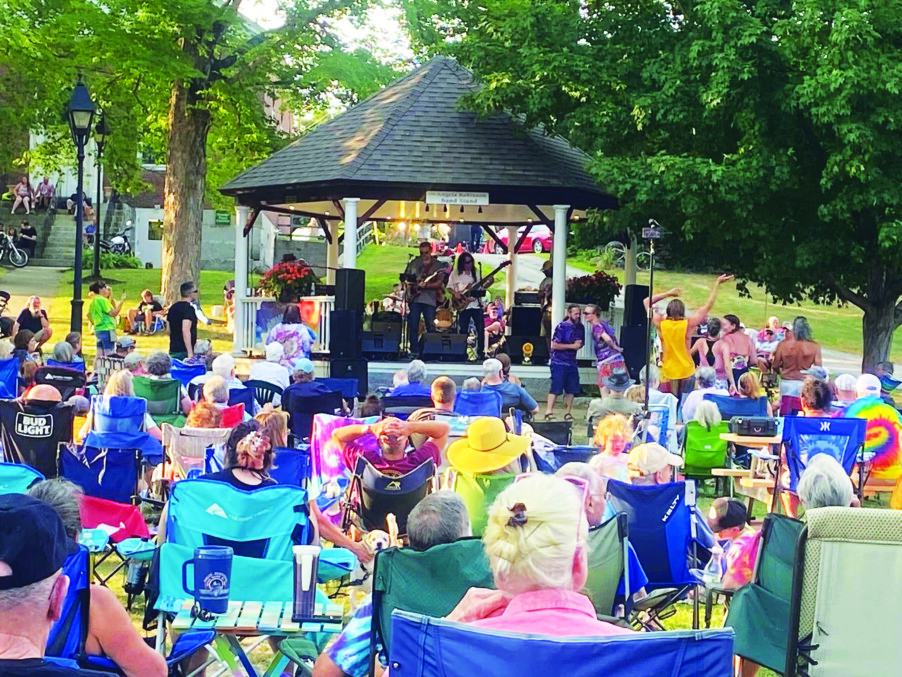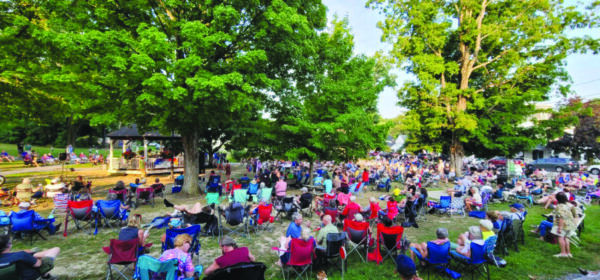Abbie Griffin Park
6 Baboosic Lake Road, Merrimack, merrimackparksandrec.org
Thursday, June 26 – Mr. Aaron’s Music
Thursday, July 3 – patriotic concert with the Merrimack Concert Association
Thursday, July 10 – Delta Generators
Thursday, July 17 – B Street Bombers
Thursday, July 24 – Renee & The Renegades
Thursday, July 31 – The Reminisants
Thursday, Aug. 7 – Captain Fantastic – The Music Of Elton John
Thursday, Aug. 14 – Blind Date Band
Thursday, Aug. 21 – Alli Beaudry
Angela Robinson Bandstand
57 Main St., Henniker, hennikerconcerts.com
Tuesday, June 24 – Scott Kirby w/ Gary Green
Tuesday, July 1 – Rebel Collective
Tuesday, July 8 – Independence Day celebration w/ Hopkinton Town Band
Tuesday, July 15 – Monkey Fingers
Tuesday, July 22 – Blues Express (Blues, Brews & BBQ Fest)
Tuesday, July 29 – Not Fade Away
Tuesday, Aug. 5 – Shana Stack Band
Tuesday, Aug. 12 – Princess Kikou
Tuesday, Aug. 19 – Dwayne Haggins Band
Tuesday, Aug. 26 – The Macrotones
BankNH Pavilion
72 Meadowbrook Lane, Gilford, banknhpavilion.com
Thursday, June 19 – Slightly Stoopid
Wednesday, June 25 – Counting Crows with The Gaslight Anthem
Friday, June 27 – Goose
Tuesday, July 1 – James Taylor
Thursday, July 3 – Kidz Bop Live!
Saturday, July 5 & Sunday, July 6 – Old Dominion
Friday, July 11 – Rod Stewart
Saturday, July 12 – Barenaked Ladies
Friday, July 18 – Styx, Kevin Cronin and Don Felder
Saturday, July 19 – Brad Paisley
Tuesday, July 22 – Dave Matthews Band
Wednesday, July 23 – Dave Matthews Band
Thursday, July 24 – Shania Twain
Saturday, July 26 – Riley Green
Sunday, July 27 – Big Time Rush
Monday, July 28 – Toto, Men At Work, Christopher Cross
Tuesday, July 29 – Pantera
Wednesday, July 30 – Black Crowes
Friday, Aug. 1 – Chicago
Sunday, Aug. 3 – Outlaw Music Festival w/ Willie Nelson and Family, Bob Dylan, Wilco
Wednesday, Aug. 6 – Goo Goo Dolls and Dashboard Confessional
Thursday, Aug. 7 – Little Big Town
Wednesday, Aug. 13 – Volbeat with Halestorm
Thursday, Aug. 14 – Bailey Zimmerman
Friday, Aug. 15 – The Black Keys
Saturday, Aug. 16 – Dropkick Murphys and Bad Religion
Sunday, Aug. 17 – Doobie Brothers
Tuesday, Aug. 19 – Steve Miller Band
Thursday, Aug. 21 – Neil Young and The Chrome Hearts
Monday, Aug. 25 – Falling In Reverse
Friday, Aug. 29 – Melissa Etheridge and Indigo Girls
Saturday, Aug. 30 – Bonnie Raitt
Monday, Sept. 1 – Tedeschi Trucks Band and Whiskey Myers
Bedford Village Common Park
15 Bell Hill Road, Bedford, bedfordnh.myrec.com
Wednesday, June 25 – Bel Airs ( ’50s doo-wop vocal quintet)
Wednesday, July 2 – The Rampage Trio (family-friendly classic rock)
Wednesday, July 9 – North River (Americana band)
Wednesday, July 16 – Knock On Wood (folk-rock duo)
Wednesday, July 23 – Endless Skies Band (good times rock)
Wednesday, July 30 – Manchester Community Music School
Bernie’s Beach Bar
73 Ocean Blvd., Hampton, berniesnh.com
Sunday, June 22 – Stephen Marley
Thursday, June 26 – Ripe (also June 27)
Sunday, June 29 – Collie Budz
Thursday, July 3 – Xzibit
Thursday, July 10 – Will Evans
Thursday, July 17 – Big Something
Sunday, July 20 – The Motet
Thursday, July 24 -Souls of Mischief
Sunday, July 27 – Wheeland Brothers
Sunday, Aug. 3 – 10 Ft. Ganja Plant
Thursday, Aug. 7 – Bumpin Uglies
Thursday, Aug. 14 – Dasha
Thursday, Aug. 21 – Aaron Lewis & The Stateliners
Tuesday, Aug. 26 – Barrington Levy
BNH Stage (CCANH)
16 S. Main St., Concord, ccanh.com
Saturday, June 21 – ICONS: Freddie Mercury
Sunday, June 22 – Hot Peas n Butter
Saturday, June 28 – Kevin Horan & Cosmic Blossom (Locally Sourced)
Sunday, June 29 – Wicked Sing Along
Wednesday, July 2 – Ranger Zone Open Mic
Friday, July 11 – Gavin Marengi Band
Friday, Aug. 1 – Zach Nugent’s Dead Set
Friday, Aug. 15 – Ryan Montbleau
Friday, Aug. 22 – Doug., the Worst & Grub Lord (Locally Sourced)
Brewster Academy
80 Academy Drive, Wolfeboro, greatwaters.org/brewster-academy
Thursday, July 24 – Abby Mueller Trio (Carole King, Joni Mitchell, James Taylor tribute)
Saturday, Aug. 16 – Peter Cincotti
Wednesday, Aug. 27 – Ted Vigil (John Denver tribute)
Casino Ballroom
169 Ocean Blvd., Hampton, casinoballroom.com
Thursday, June 26 – Steel Pulse
Friday, June 27 – The Movement & Tribal Seeds w/ Mike Love
Saturday, June 28 – Voyage (Journey Tribute)
Saturday, July 5 – Badfish: A Tribute to Sublime
Wednesday, July 9 – The Elovaters w/ Mihali
Thursday, July 10 – Ryan Adams
Friday, July 11 – Fab Four – Beatles tribute
Saturday, July 12 – Michael Franti & Spearhead
Sunday, July 13 – Buddy Guy
Friday, July 18 – Trevor Hall
Saturday, July 19 – Dark Desert Eagles
Wednesday, July 23 – Russell Dickerson
Friday, July 25 – 49 Winchester with Wesko
Saturday, July 26 – Little River Band
Saturday, Aug. 2 – Mat Kearney
Sunday, Aug. 3 – Happy Together Tour
Wednesday, Aug. 6 – Air Supply
Thursday, Aug. 7 – Yacht Rock Revue
Friday, Aug. 8 – Gimme Gimme Disco
Sunday, Aug. 10 – Cooper Alan
Wednesday, Aug. 13 – David Lee Roth
Friday, Aug. 15 – The Struts
Saturday, Aug. 16 – Tributes: Dirty Deeds (AC/DC) and Cathedral (Van Halen)
Wednesday, Aug. 20 – Joe Perry Project
Thursday, Aug. 21 – Dylan Scott
Friday, Aug. 22 – Brit Floyd
Saturday, Aug. 23 – Get the Led Out
Sunday, Aug. 24 – Tyler Hubbard
Wednesday, Aug. 27 – Andy Grammer
Thursday, Aug. 28 – Extreme
Friday, Aug. 29 – One Night of Queen
Saturday, Aug. 30 – Face 2 Face – A Tribute to Elton John and Billy Joel
Sunday, Aug. 31 – KC & The Sunshine Band
Chubb Theatre (CCANH)
44 S. Main St., Concord, ccanh.com
Saturday, June 21 – Dionne Warwick
Colonial Theatre
609 Main St., Laconia, coloniallaconia.com
Thursday, July 10 – The High Kings
Saturday, Aug. 2 – Mary Chapin Carpenter / Brandy Clark
Wednesday, Aug. 27 – One Night of Queen
Crows’ Feat Farm
178-180 Drinkwater Road, Kensington, crowsfeatfarm.org
Sunday, June 22 – Trifecta
Sunday, July 13 – Gnarly Darling
Sunday, July 27 – Reed Foehl
Sunday, Aug. 10 – Kate Prascher
Sunday, Aug. 24 – A Classical Collaboration
Emerson Park
6 Mont Vernon St., Milford, milfordnh.recdesk.com
Wednesday, July 16 – Mango Groove Steel Band
Wednesday, July 23 – The Temple Band
Wednesday, July 30 – 50 Shades of Blue
Wednesday, Aug. 6 – Rockin Daddies 50s 60s
Wednesday, Aug. 13 – Tru Diamond
Field of Dreams
48 Geremonty Drive, Salem, fieldofdreamsnh.org
Friday, June 20 – Foreigners Journey
Friday, June 27 – Souled Out Show Band
Friday, July 11 – Champagne Casanova
Friday, July 18 – R3d N3ck Castaway Band
Thursday, July 24 – Brandy Band
Thursday, July 31 – The Salem Boyz
Friday, Aug. 15 – B Street Bombers
Friday, Aug. 22 – Madhouse Party Band
Greeley Park Band Shell
100 Concord St., Nashua, nashuanh.gov/546/SummerFun
Tuesday, June 24 – B Street Bombers
Tuesday, July 1 – After Hours Big Band
Friday, July 4 – The Slakas
Tuesday, July 8 – Rico Barr Band
Tuesday, July 15 – Bedford Big Band
Monday, July 21 – Tru Diamond
Saturday, July 26 – Bel Airs (’50’s doo-wop vocal quintet)
Tuesday, July 29 – American Legion
Tuesday, Aug. 19 – Hangfire Band
Hampstead Public Library Stage
9 Mary E Clark Drive, Hampstead, hampsteadlibrary.org
Wednesday, July 2 – Steve Blunt and Friends
Wednesday, July 9 – High Range Bluegrass Band
Wednesday, July 16 – Monadnock Bluegrass Band
Wednesday, July 23 – Mr. Aaron
Wednesday, July 30 – Relative Soul
Wednesday, Aug. 6 – The Last Duo
Wednesday, Aug. 13 – Classic Rain
The Keyes Stage
45 Elm St., Milford, milfordnh.recdesk.com
Wednesday, July 2 – Cover Story
Wednesday, July 9 – Rampage Trio
Wednesday, Aug. 20 – Scenes – A Billy Joel Tribute
Wednesday, Aug. 27 – Compaq Big Band
Londonderry Town Common
265 Mammoth Road, Londonderry, londonderryartscouncil.org/cotc-schedule
Wednesday, June 25 – East Coast Soul
Wednesday, July 2 – Cool Cool Cool
Wednesday, July 9 – Bruce Marshall Group
Saturday, July 12 – Steve Blunt & Friends (children’s)
Sunday, July 13 – Studio Two (Beatles tribute)
Wednesday, July 16 – Brian Maes Band
Wednesday, July 23 – Chicago Total Access
Wednesday, July 30 – Delta Generators
Wednesday, Aug. 6 – Martin and Kelly
MainStreet Stage
16 E Main St., Warner, mainstreetwarnerinc.org
Sunday, June 22 – Colin Nevins
Tuesday, July 8 – Saline Fiddlers Philharmonic
Friday, July 18 – Now’s The Time
Friday, Aug. 1 – Trade
Saturday, Aug. 16 – Manning & McBrian
Meetinghouse Park
11 Main St., Hampstead, hampsteadcabletv.com/concert-series
Tuesday, July 1-Timberlane Community Band
Tuesday, July 8 – Time Bandits
Tuesday, July 15 – The Redneck Castaway Band
Tuesday, July 22 – Haggard and Cashed
Tuesday, July 29 – Tru Diamond
Tuesday, Aug. 5 – Mark 209
Tuesday, Aug. 12 – Rick Anthony as Elvis
Tuesday, Aug. 26 – Martin & Kelly
Music Hall
28 Chestnut St., Portsmouth, themusichall.org
Thursday, June 19 – Shawn Colvin & Rodney Crowell
Friday, June 20 – Arrival From Sweden (ABBA tribute)
Sunday, June 22 – Allman Betts Band
Thursday, July 3 – Rumors ATL (Fleetwood Mac tribute)
Saturday, July 12 – Straight No Chaser
Saturday, July 19 – Drew & Ellie Holcomb
Tuesday, Aug. 26 – The Temptations
Music Hall Lounge
131 Congress St., Portsmouth, themusichall.org
Saturday, June 21 – Chris Trapper
Friday, June 27 – Veronica Lewis
Saturday, June 28 – Mr. Sun
Sunday, July 13 – Once An Outlaw
Wednesday, July 16 – Tony Furtado
Saturday, July 19 – Night of Sinatra w/ Rich DiMare and Ron Poster
Sunday, July 20 – Bitter Pill
Friday, July 25 – Walter Parks & the Unlawful Assembly
Saturday, July 26 – Sarah Blacker & the Light
Friday, Aug. 22 – Mark Erelli
Saturday, Aug. 23 – Sharon Jones
Sunday, Aug. 31 – David Wax Museum
New Boston Common Gazebo
5 Meetinghouse Hill Road, New Boston, newbostonnh.gov
Tuesday, June 24 – Freese Brothers Big Band
Tuesday, July 8 – Hickory Horned Devils
Tuesday, July 22 – The Slakas
Tuesday, Aug. 5 – The Bel Airs
Tuesday, Aug. 19 – Endless Skies Band
North Hampton Bandstand
Route 111 & Route 151, North Hampton, northhamptonbandstand.com/calendar
Wednesday, June 25 – The Visitors
Wednesday, July 2 – Redemption Band
Wednesday, July 9 – Tru Diamond w/ Tony Funches (Platters)
Wednesday, July 16 – Counterfeit Cash tribute band
Wednesday, July 23 – New Legacy Swing Band
Wednesday, July 30 – J.C. Underhill Band with the Elvis Experience
Wednesday, Aug. 6 – Mark 209
Wednesday, Aug. 13 – Rico Barr & the JJR Horns
Wednesday, Aug. 20 – Studio Two (Beatles tribute)
Wednesday, Aug. 27 – Club Soda
Palace Theatre
80 Hanover St., Manchester, palacetheatre.org
Friday, June 27 – Somebody to Love – Queen tribute (also 6/28)
Saturday, Aug. 23 – NH Irish Festival
Rex Theatre
23 Amherst St., Manchester, palacetheatre.org
Friday, June 20 – Willie Nile
Saturday, June 28 – Scott Spradling Band: Music At The Movies
Friday, July 11 – BoStyx – Boston & Styx tribute
Saturday, July 12 – Roomful of Blues
Saturday, July 19 – Silver Springs – Fleetwood Mac tribute
Saturday, July 26 – Rob Ickes & Trey Hensley
Friday, Aug. 1 – Rush Experience (Rush tribute)
Friday, Aug. 22 – Traveling Wilburys tribute
Sea Shell Stage
180 Ocean Blvd., Hampton, hamptonbeach.org
Thursday, June 19 – Angela West & Showdown
Friday, June 20 – Brandy Band
Saturday, June 21 – Radio Roulette
Sunday, June 22 – Christian Music Festival
Monday, June 23 – Viva Las Elvis: A Tribute to Elvis Presley
Tuesday, June 24 – Billy D and the Rock-its
Wednesday, June 25 – The Reminisants
Thursday, June 26 – Line Dance Lessons with Nashville Line Dance
Thursday, June 26 – TBA
Friday, June 27 – Something Stupid
Saturday, June 28 – HIJACKED
Sunday, June 29 – Backtrack Band
Monday, June 30 – The Apathetics
Tuesday, July 1 – Scenes
Wednesday, July 2 – The Continentals
Thursday, July 3 – Line Dance Lessons with Nashville Line Dance
Thursday, July 3 – Timothy James
Friday, July 4 – Brandy Band
Saturday, July 5 – Mischief Mile
Sunday, July 6 – Club Soda
Monday, July 7 – Rob Bellamy
Tuesday, July 8 – Line Dance Lessons with Nashville Line Dance
Wednesday, July 9 – Stefanie Jasmine Band
Thursday, July 10 – Line Dance Lessons with Nashville Line Dance
Thursday, July 10 – Niko Moon w/ David J
Friday, July 11 – Small Town Stranded
Saturday, July 12 – The Bel Airs
Sunday, July 13 – B Street Bombers
Monday, July 14 – Being Petty: Tom Petty Tribute
Tuesday, July 15 – The Apathetics
Wednesday, July 16 – Beat Street
Thursday, July 17 – Lessons with Nashville Line Dance
Thursday, July 17 – Fiddle Fire
Friday, July 18 – Leaving Eden
Saturday, July 19 – Radio Roulette
Sunday, July 20 – World Premier Band
Monday, July 21 – Viva Las Elvis: A Tribute to Elvis Presley
Tuesday, July 22 – Takin’ It To The Streets
Wednesday, July 23 – Scott Brown and the Diplomats
Thursday, July 24 – Line Dance Lessons with Nashville Line Dance
Thursday, July 24 – Angela West and Showdown
Friday, July 25 – Neurotic Gumbo
Saturday, July 26 – The Reminsants
Sunday, July 27 – The Rico Barr Band featuring the JJR Horns
Monday, July 28 – 13 Black
Tuesday, July 29 – Dancing Madly Backwards
Wednesday, July 30 – Ayla Brown
Thursday, July 31 – Line Dance Lessons with Nashville Line Dance
Thursday, July 31 – April Cushman
Friday, Aug. 1 – Billy D and the Rock-its
Saturday, Aug. 2 – Redemption
Sunday, Aug. 3 – Salem Boyz
Monday, Aug. 4 – The Apathetics
Tuesday, Aug. 5 – The GemsTones
Wednesday, Aug. 6 – Boyz Gone Wild
Thursday, Aug. 7 – Line Dance Lessons with Nashville Line Dance
Thursday, Aug. 7 – Vinny B Band
Friday, Aug. 8 – Sophie Patenaude
Saturday, Aug. 9 – 39th Army Band
Sunday, Aug. 10 – Beat Street
Monday, Aug. 11 – Tru Diamond
Tuesday, Aug. 12 – The Little Mermen
Wednesday, Aug. 13 – Club Soda
Thursday, Aug. 14 – Line Dance Lessons with Kevin Richards
Thursday, Aug. 14 – Martin and Kelly
Friday, Aug. 15 – The Reminsants
Saturday, Aug. 16 – Radio Roulette
Sunday, Aug. 17 – Deep Blue C Orchestra
Monday, Aug. 18 – Mark 209
Tuesday, Aug. 19 – All Summer Long
Wednesday, Aug. 20 – Key West Days in Hampton Beach
Thursday, Aug. 21 – Line Dancing Lessons with Chris Lefebvre
Thursday, Aug. 21 – Kevin White
Friday, Aug. 22 – Talent Competition
Saturday, Aug. 23 – Talent Competition
Sunday, Aug. 24 – Talent Competition
Monday, Aug. 25 – Viva Las Elvis: A Tribute to Elvis Presley
Tuesday, Aug. 26 – Blues Brothers the Next Generation
Wednesday, Aug. 27 – Brandy Band
Thursday, Aug. 28 – Line Dance Lessons with Nashville Line Dance
Thursday, Aug. 28 – Angela West and Showdown- Country
Friday, Aug. 29 – The Continentals
Saturday, Aug. 30 – “Cirque du Hampton Beach”
Sunday, Aug. 31 – The Reminsants
Monday, Sept. 1 – Leaving Eden
Stark Park
650 River Road, Manchester, starkpark.com
Saturday, June 21 – Miss Alli Kids Concert
Sunday, June 29 – New Legacy Swing Band
Sunday, July 6 – Love Dogs
Sunday, July 13 – Wolverine Jazz Band
Sunday, July 20 – Another Tequila Sunrise (Eagles tribute)
Sunday, July 27 – Swing Times Five
Sunday, Aug. 3 – Something Wonderful Tonight (Eric Clapton tribute)
Sunday, Aug. 10 – Studio Two (Beatles tribute)
Sunday, Aug. 17 – Windham Concert Band
Monday, Aug. 18 – Manchester Community Summer Band
Sunday, Aug. 24 – Compaq Big Band
The Range
96 Old Turnpike Road, Mason, therangemason.com
Friday, June 20 – Chris Janson
Saturday, June 21 – Pepper w/ Cydeways
Friday, June 27 – Zach Deputy w/ Fox and the Flamingos
Saturday, June 28 – Town Meeting w/ Connor Watson
Saturday, July 5 – Pure Prairie League & The Weight Band w/ The Incidentals
Thursday, July 10 – Lovewhip
Saturday, July 12 – Once an Outlaw & The Peacheaters
Thursday, July 17 – Annie Brobst
Saturday, July 19 – Max Creek
Saturday, July 26 – The New Mastersounds w/ Funk You
Sunday, Aug. 3 – Johnny Burgin
Saturday, Aug. 16 – The SteelDrivers w/ Charlie Chronopoulos
Friday, Aug. 29 – Jennifer Hartswick Band / The Nth Power / Hayley Jane Band
Tupelo Music Hall
10 A St., Derry, tupelomusichall.com
Friday, June 20 – Mike Tramp’s White lion w/ All Sinners
Saturday, June 21 – Magical Mystery Doors – Beatles, Zeppelin, Doors tribute
Sunday, June 22 – Curtis Salgado
Tuesday, June 24 – Robin Trower (sold out)
Saturday, June 28 – Australian Bee Gees Show
Friday, July 11 – Dueling Pianos
Saturday, July 12 – Beginnings – Chicago tribute
Sunday, July 13 – Howie Day
Friday, July 18 – Slippery When Wet – Bon Jovi tribute
Saturday, July 19 – Jerrod Niemann
Wednesday, July 23 – Direct From Sweden – ABBA tribute (also 7/24)
Friday, July 25 – Postmodern Jukebox
Saturday, July 26 – Live at The Fillmore – Allman Brothers tribute
Sunday, July 27 – Sweet
Tuesday, July 29 – Rick Wakeman
Saturday, Aug. 2 – Atlanta Rhythm Section
Sunday, Aug. 10 – Cherry Cherry – Neil Diamond tribute
Tuesday, Aug. 12 – Stryper
Friday, Aug. 15 – Naturally 7
Saturday, Aug. 16 – Ozomatli
Friday, Aug. 22 – Queensryche w/ All Sinners
Thursday, Aug. 28 – Majesty – Queen tribute
Friday, Aug. 29 – Broken Hearts – Tom Petty tribute
Saturday, Aug. 30 – Slaughter
Sunday, Aug. 31 – Justin Hayward
Village Green
6 Village Green, Pelham
Wednesday, July 9- Standard Tuning
Wednesday, July 23 – The Casuals
Wedensdasy, Aug. 6- 4 Ever Fab Band and Cruise Night (Car Show)
Wednesday, Aug. 13 – Everlasting Characters (Royal Ball)
Word Barn
66 Newfields Road, Exeter, thewordbarn.com
Friday, June 20 – Soggy Po’ Boys
Sunday, June 22 – Antje Duvekot
Thursday, June 26 – Allegra Krieger
Friday, June 27 – Rock My Soul
Sunday, July 6 – The Lost River Fleet
Friday, July 11 – The Wolff Sisters
Saturday, July 19 – AJ Lee & Blue Summit
Sunday, July 20 – Dean Johnson & Erin Rae
Wednesday, July 23 – Jake Xerxes Fussell
Friday, Aug. 1 – Dead to the Core
Friday, Aug. 15 – Joe Pug
Saturday, Aug. 16 – Joe Pug
Sunday, Aug. 17 – Todd Hearon w/Big Sweetie
Thursday, Aug. 21 – Kissing Other PPL ft Rachel Baiman + Viv & Riley








